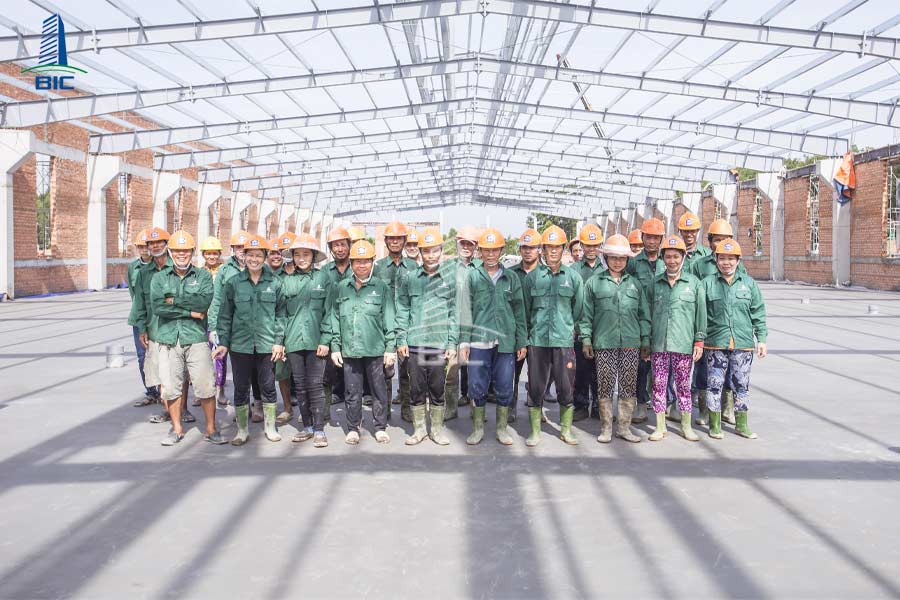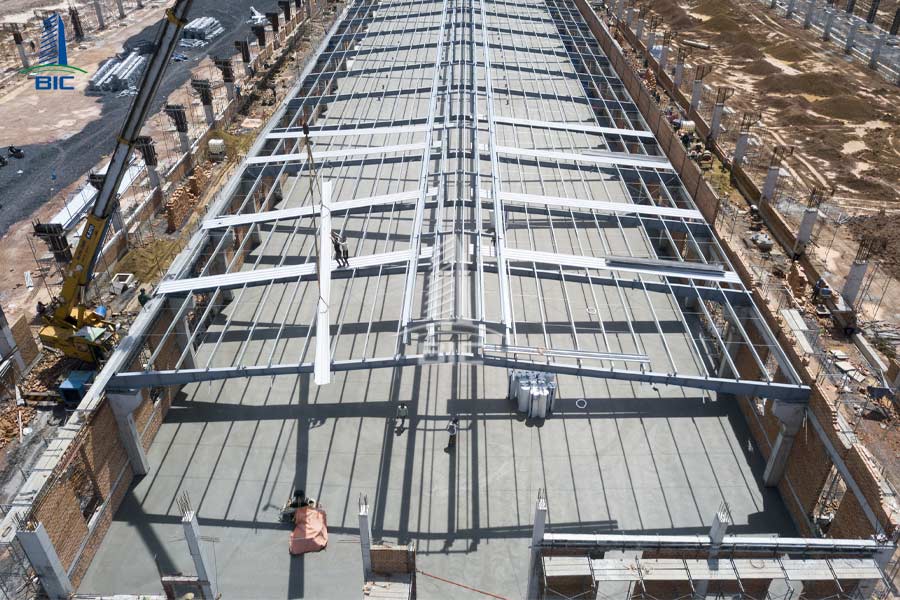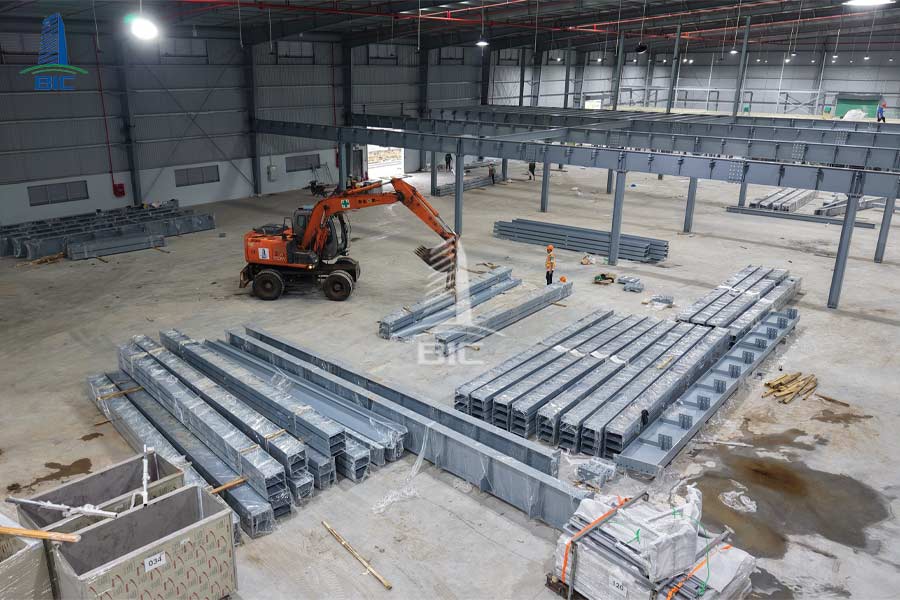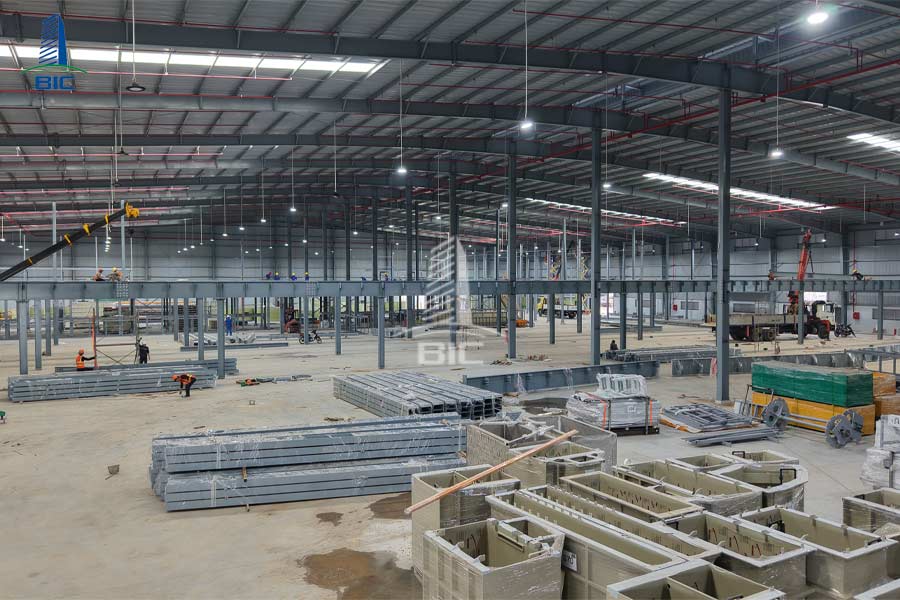
Steel structures are increasingly being applied in factory design thanks to their outstanding advantages in durability, load-bearing capacity, and construction speed. Unlike traditional concrete structures, factory designs using steel structures allow for prefabrication at the factory, rapid assembly on site, and flexibility in expansion or renovation when production needs change.
In the factory construction design process, choosing steel structures not only optimizes project timelines but also ensures the highest quality standards. Understanding the characteristics, advantages and disadvantages, construction process, and practical applications of steel structures helps investors make informed decisions that meet technical requirements while delivering long-term economic benefits.
Steel structures in factory construction refer to the main load-bearing frame system, consisting of steel components such as columns, rafters, purlins, bracing systems, and bolted or welded connections. This is the “backbone” of the building, ensuring load-bearing capacity, vibration resistance, and stability for the entire structure throughout its service life.
In the factory design process, steel structures are carefully calculated for both static and dynamic loads to meet safety standards while being suitable for the intended production functions. Depending on the scale and operational characteristics of the factory, the design can adopt pre-engineered steel frames, composite steel structures, or arch-shaped steel frames.
A key advantage of steel structures is that they can be fully fabricated at the factory, significantly reducing on-site construction time and labor costs. This is why more and more investors are prioritizing steel structures for modern factory projects, especially where fast construction timelines, durable structures, and future expansion are required.

Steel structures allow for full prefabrication at the factory and quick assembly on site. In factory construction design, using steel structures can shorten project timelines by 30–50% compared to traditional concrete methods, enabling investors to put facilities into operation sooner.
When designing a factory with steel structures, engineers can leverage the superior mechanical properties of steel to withstand heavy loads, resist vibrations, and minimize deformation. Combined with protective coatings or galvanization, steel structures have long service life and excellent corrosion resistance in various environmental conditions.
Steel structures are especially suitable for factory projects with future expansion plans. Thanks to their modular design, buildings can be dismantled, reconfigured, or extended without affecting the main structure.
Compared to concrete, steel is significantly lighter, reducing the load transferred to the foundation. This allows for more economical foundation designs, shorter construction times, and lower initial investment costs.
Steel is recyclable and reusable, helping reduce construction waste. In addition, steel structure factory designs easily integrate green solutions such as solar power systems, natural ventilation, and insulation materials to improve operational energy efficiency.

In factory projects using steel structures, regular anti-corrosion maintenance is necessary, especially in humid environments, coastal areas, or where corrosive chemicals are present. Neglecting this can significantly reduce the structure’s lifespan and compromise safety.
While steel structures save time and foundation costs, high-quality steel materials and precision fabrication during the design stage may cost more than some traditional concrete options. However, this investment is often offset by faster returns and lower operating costs.
Designing and constructing steel structures require high precision in fabrication and assembly. Inexperienced contractors can cause misalignments, reduce load-bearing capacity, or incur costly repairs.
Steel conducts heat quickly, so effective heat and sound insulation solutions are necessary in factory construction. This may require adding insulation layers, soundproof panels, or appropriate ventilation systems to maintain a stable working environment.

Before starting construction, engineers survey the site conditions, assess the geology, and review infrastructure. This data is used to finalize detailed construction designs, including structural plans, foundations, technical systems, and assembly methods.
Steel components are precisely manufactured at the factory according to design drawings. This includes cutting, welding, drilling bolt holes, and surface treatment (anti-rust painting or galvanization). Prefabrication ensures consistent quality and reduces on-site construction time.
After fabrication, components are transported to the site and assembled following technical procedures. The assembly process must be carried out by skilled personnel using appropriate lifting equipment to ensure safety and accuracy.
Once the steel frame is complete, the factory construction proceeds with cladding, roofing, doors, flooring, electrical and plumbing systems, and fire protection. Each stage undergoes quality checks to ensure compliance with technical standards and investor requirements.
The final step involves comprehensive inspection, including dimensional accuracy, load-bearing performance, surface protection, and auxiliary systems. The facility is handed over with technical documentation and maintenance guidelines.

In manufacturing projects, steel structures are preferred for their ability to span large widths without intermediate columns, providing open spaces for equipment layout and operations. Pre-engineered steel frame designs maximize functionality and reduce commissioning time.
Storage facilities, distribution centers, and logistics hubs often require large floor areas and high roof or floor loads. Steel structures meet these needs and allow integration of cranes, conveyors, and large-scale loading/unloading systems.
The combined factory-and-office model is increasingly popular. Steel structures enable flexible layouts between production areas and workspaces, ensuring aesthetics, functionality, and scalability.
Beyond standard factories, steel structures are used in specialized facilities such as food processing plants, pharmaceutical factories, and precision engineering workshops. These require strict environmental, hygiene, and safety standards that steel structures can effectively meet.
A professional contractor should demonstrate their capabilities through completed factory construction projects. Portfolios should include design drawings, construction photos, and client feedback as a basis for evaluating quality, work style, and technical competence.
A reputable design and construction firm must have engineers and architects knowledgeable in steel structures, MEP systems, and fire safety standards. Experience in various types of factory construction allows them to propose solutions that are technically sound and cost-effective.
From site surveys and design proposals to steel structure construction, finishing, and handover, each stage should follow a clear process with specific timelines and transparent acceptance standards.
A reliable contractor must have a binding contract covering material specifications, construction quality, delivery schedule, and warranty terms. Meeting deadlines allows investors to save time and commence operations sooner.
Steel structures have proven their importance in modern factory design and construction. Thanks to their speed of construction, load-bearing strength, flexibility, and durability, they are an optimal solution for many types of industrial projects. However, to maximize the value of steel structures, choosing the right design approach and a reputable contractor is essential.
A sound investment decision not only delivers a facility that meets technical and aesthetic standards but also optimizes costs, shortens operational timelines, and builds a foundation for sustainable growth. Contact BIC today for expert advice on the optimal steel structure solution for your project. We are ready to assist from site survey and factory design to construction and handover, with guaranteed quality, timelines, and investment efficiency.